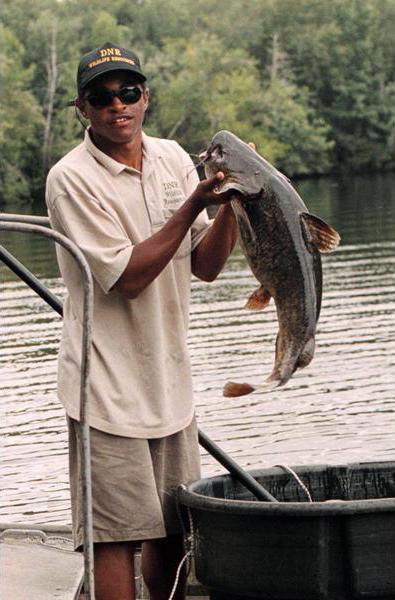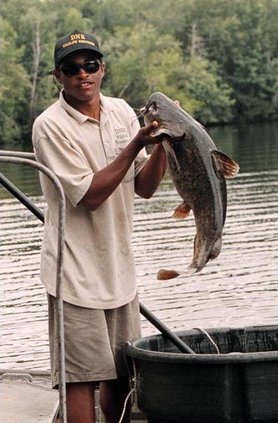WAYCROSS, Ga. (AP) — State biologists hope electric shocks can help them remove a voracious, nonnative catfish from a south Georgia river where it is devouring native fish.
A crew of three DNR biologists is on the Satilla River three or four days a week, sending an electrical charge into the water that temporarily stuns the giant flathead catfish. Then they grab them up in nets and remove them permanently from one of Georgia’s most pristine rivers.
Under a flathead eradication project that was funded during the 2006 legislative session, the three-member crew will be on the river from April until October.
Bert Deener, regional supervisor of the DNR’s Fisheries Office in Waycross, said that before this new initiative, no personnel were dedicated to the task full time. Spotty efforts to reduce the flathead population could not keep up with the rapid rate of reproduction.
Since beginning just over a week ago, Deener’s crew already has removed 700 pounds of flathead catfish from the river.
Satilla Riverkeeper Gordon Rogers said flatheads were introduced to the Satilla around 10 years ago. They devastate native species such as the redbreast, he said. Flatheads can grow to 50 pounds and more.
‘‘They have pressed immense destruction on the native sunfish population, particularly redbreasts, native catfish populations and other native fish,’’ Rogers said.
The state is funding the project at $200,000 a year.
‘‘It’s going to take between 10 and 20 years, but we’re going to get them under control,’’ Rogers said. ‘‘We may not wipe them out, but they’ll be at a low level.’’
Meanwhile, a permanent solution to the flathead problem may come in the laboratory. Biologists are looking for a genetic flaw that can be bred into the stock to cause sterility or some other method of reducing or eliminating the species from the Satilla.
Flathead haters from all over the eastern seaboard will be watching the Satilla project closely, Deener said, since a solution that works here may also work on other rivers plagued by the fish.
The Satilla rises near Douglas and then flows through or touches Ware, Pierce, Brantley and Camden counties.
———
Information from: The Florida Times-Union, http://www.jacksonville.com
A crew of three DNR biologists is on the Satilla River three or four days a week, sending an electrical charge into the water that temporarily stuns the giant flathead catfish. Then they grab them up in nets and remove them permanently from one of Georgia’s most pristine rivers.
Under a flathead eradication project that was funded during the 2006 legislative session, the three-member crew will be on the river from April until October.
Bert Deener, regional supervisor of the DNR’s Fisheries Office in Waycross, said that before this new initiative, no personnel were dedicated to the task full time. Spotty efforts to reduce the flathead population could not keep up with the rapid rate of reproduction.
Since beginning just over a week ago, Deener’s crew already has removed 700 pounds of flathead catfish from the river.
Satilla Riverkeeper Gordon Rogers said flatheads were introduced to the Satilla around 10 years ago. They devastate native species such as the redbreast, he said. Flatheads can grow to 50 pounds and more.
‘‘They have pressed immense destruction on the native sunfish population, particularly redbreasts, native catfish populations and other native fish,’’ Rogers said.
The state is funding the project at $200,000 a year.
‘‘It’s going to take between 10 and 20 years, but we’re going to get them under control,’’ Rogers said. ‘‘We may not wipe them out, but they’ll be at a low level.’’
Meanwhile, a permanent solution to the flathead problem may come in the laboratory. Biologists are looking for a genetic flaw that can be bred into the stock to cause sterility or some other method of reducing or eliminating the species from the Satilla.
Flathead haters from all over the eastern seaboard will be watching the Satilla project closely, Deener said, since a solution that works here may also work on other rivers plagued by the fish.
The Satilla rises near Douglas and then flows through or touches Ware, Pierce, Brantley and Camden counties.
———
Information from: The Florida Times-Union, http://www.jacksonville.com

